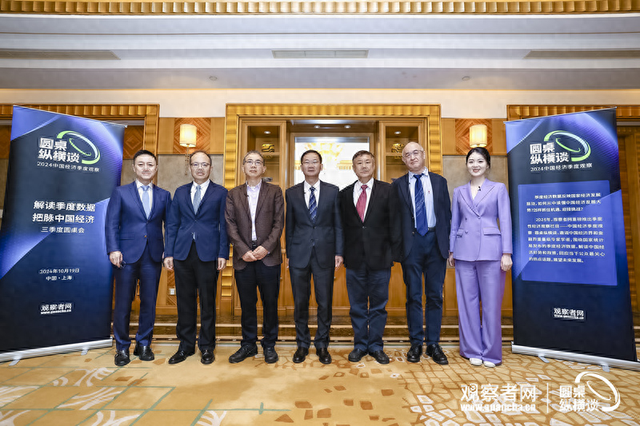
On 18 September, the US Federal Reserve announced an interest rate cut, and in the month after that, China’s economic policy underwent a major shift, with new policies being unveiled from the highest decision-making level to various government departments related to the economy.
First, on 24 September, the three major financial authorities held a press conference; followed by the Central Political Bureau meeting on 26 September, and then the State Council executive meeting on 29 September, after which conferences by the NDRC and the Ministry of Finance followed.
CEIBS Professor Sheng Songcheng, Senior Researcher Fellow of the Academic Committee of National Development and Reform Commission (NDRC) Zhang Yansheng, CICC Chief Economist Peng Wensheng, Chief Economist and Director of Market Research at Industrial Bank Lu Zhengwei, Vice Chairman of the China Society of Urban Planning, Zhao Yancheng, focusing on the third-quarter economic data and the recently introduced package of incremental policies, to discuss China’s economic reforms.
The recently launched incremental policy package focuses on five key areas: macro counter-cyclical adjustment, expanding domestic demand, assisting enterprises, boosting the capital market, and stabilizing real estate. Evaluating this package requires reflection on our reform and opening-up experiences. Historically, China assesses economic development primarily through GDP and total factor productivity (TFP). Between 2002 and 2008, China’s GDP grew at an impressive average annual rate of 10.47%, with TFP growing at 4.2%.
This growth period signifies a peak in new quality productivity, characterized by a significant increase in TFP. This era, particularly from 2002 to 2008, represents the best development of new quality productivity in China over the past 45 years.
Two factors contributed to this achievement. First, the policy package implemented from 1998 to 2002 was a timely response to insufficient domestic demand, involving the issuance of 660 billion yuan in long-term construction treasury bonds, which catalyzed 3.2 trillion yuan in investments.
Second, from 1998 to 2002, significant financial reforms occurred, including introducing strategic investors. I see parallels between this historical context and today’s incremental policy packages, which aim to replicate high GDP and TFP growth.
From 2009 to 2022, however, there was the slowest GDP growth in 45 years, averaging just 7% annually, with TFP growth declining to between 1.21% and 1.3% in recent years.
In the medium term, the incremental policy package seeks to address the lack of endogenous momentum, focusing on rebuilding confidence and expectations. The long-term objective involves improving the debt situations of local governments, enterprises, and residents. China must determine how these policies can drive structural adjustments from 2024 to 2027, paving the way for sustainable growth post-2028.
Two perspectives emerged in our earlier discussions: one advocates for long-term stimulus across the stock market, real estate, and local debts, while the other emphasizes solving issues in the short, medium, and long term. Clarifying the problems facing the Chinese economy across these timelines is essential for effective policy implementation.
Now, China’s reform focus should align with the priorities outlined in the Third Plenary Session of the 20th Central Committee, including central-local fiscal relations. It’s time to advance reforms in these crucial areas and re-evaluate China’s relationship with global investments.
At this stage and for the foreseeable future, China’s primary goal should be to improve the TFP indicator. While discussions about supply-side and demand-side reforms are crucial, an emphasis on demand-side reforms may not necessarily elevate TFP, even if GDP growth improves. Selling goods at lower prices can boost GDP without enhancing TFP growth. The challenge lies in reconciling the fluctuations between these two indicators.
As China transitions from a populous nation to a major economy, its global role must shift from tension to harmony. Demand will serve as the foundation for future Chinese-style modernization.
From a technical standpoint, TFP pertains to supply-side analysis, but demand remains critical. Prolonged low economic demand leads to high youth unemployment, adversely impacting human capital accumulation and resulting in diminished TFP. Thus, China cannot afford extended periods of insufficient demand.
Moreover, the demand and supply attributes differ across industries. For instance, while China’s green industry is thriving, the real estate sector’s growth is sluggish. Many investors question whether green industry development can compensate for the real estate sector’s weakness. Comparing the two directly is misleading due to their differing supply and demand characteristics.
Land typically exhibits diseconomies of scale, meaning output per acre cannot be increased through merely scaling up land use. Land ownership has enduring advantages due to its infinite lifespan, unlike labor, which is finite.
Furthermore, export demand enhances TFP, as it primarily stems from the manufacturing sector, where large-scale production fosters efficiency and cost reductions. In contrast, while a real estate boom can temporarily boost demand, it negatively impacts TFP. This is due to the absence of economies of scale in real estate and its monopolistic nature, which stifles production efficiency and technological advancement. Therefore, when discussing demand, it is essential to consider the type of demand involved.
The Chinese economy faces constraints primarily from the production side, highlighting the issue of surplus labor due to insufficient demand. Enhancing labor productivity in this context may hinder employment growth, suggesting that the expansion of the debt side—through capital creation—is essential for addressing labor surpluses and stimulating economic activity. And both the supply and demand sides require improvement for sustained economic growth.
By referring to historical economic divergences and convergences, particularly the importance of innovation capacity and market scale, the U.S. leads in innovation partly due to its large market, which fuels demand and, consequently, encourages innovation.
The participants also highlight the role of government and market synchronization in fostering innovation and productivity. Advancements in military technology, for instance, must be effectively transferred to civilian applications to enhance total factor productivity (TFP).
Source: sina



